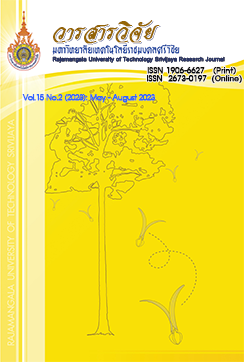Growth and Yield of Marigold Planted in Songkhla Province
Keywords:
marigold, growth, yield, variety, SongkhlaAbstract
Growth and yield of twenty varieties of marigold were evaluated at Agricultural Innovation and Management Division, Faculty of Natural Resources, Prince of Songkla University, Hat Yai district, Songkhla province during February and June 2018. The experimental design was a Randomized Complete Block Design (RCBD) with 4 replications. The aim of this study was to select suitable varieties for commercial growing in Songkhla province and nearby areas. It was found that all of marigold varieties had a survival rate higher than 80% at 30 days after transplanting with good vegetative growth performances and high flower yield ranging from 121,174.85-193,886.87 flowers/ rai. Moreover, the results revealed that varieties TLG 5011 F1, Sri siam gold, F1 Noppakun gold, Cana gold extra and Tongtep 05 tolerated to diseases and had the number of flowers ranging from 158,579.76-189,824.60 flowers/ rai, flower size at 3.52-8.62 cm in diameter, prolong vase life of marigold for 6.00-9.25 days and yellow - orange color which are marketable in Hat Yai district, Songkhla province.
References
Ahmad, I., Asif, M., Amjad, A. and Amad, S. 2011. Fertilization enhances growth, yield and xanthophyll contents of marigold. Turkish Journal of Agriculture and Forestry 35: 641-648.
Department of Agricultural. 2017. Quantity and value of flowering plants. Ministry of Agriculture and Cooperatives, Bangkok. (in Thai)
Department of Agricultural Extension. 2018. Marigold Planting Information Report. Available Source: http://www.agriinfo.doae.go.th/year61/plant/rortor/flower/marigold1.pdf, June 6, 2018. (in Thai)
Gupta, P. and Vasudeva, N. 2012. Maligold a potential ornamental plant drug. Hamdard Medicus 55: 352-364.
Kannika, T. 1998. Varietal studies in 14 varieties of American Marigold (Tagetes erecta). Special problem, Department of horticulture, Kasetsart University. (in Thai)
Kasemsap, S. 1989. Flowering Pot Plants. Akson Phitthaya Printing House, Bangkok. (in Thai)
Kho Hong Agrometeorological Station. 2018. Annual Meteorological Report 2018. Meteorological Department, Songkhla. (in Thai)
Kurakula, D., Girwani1, A., Vijaya, D. and Prashanth, P. 2017. Effect of levels of fertigation on growth and flowering of marigold (Tagetes erecta L.) CV. Pusa Narangi Gainda. International Journal of Current Microbiology and Applied Sciences 6: 1146-1151.
Narsude, P.B., Kadam, A.S. and Patil, V.K. 2010. Studies on the growth and yield attributes of different African Marigold (Tagetes erecta L.) genotypes under Marathwada condition. Asian Journal of Horticulture 5: 284-286.
Sangwan, P., Garg, V.K. and Kaushik, C.P. 2010. Growth and yield response of marigold to potting media containing vermicompost produced from different wastes. Environmentalist 30: 123-130.
Shivakumar,V. and Srinivasa, V. 2017. Estimation of chlorophyll content of leaf, growth and yield of marigold (Tagetes erecta L.) genotypes under hill zone of Karnataka. International Journal of Pure & Applied Bioscience 5: 1000-1004.
Soonsuwon, W. 2002. Research Methods in Agriculture. Department of Plant Science, Faculty of Natural Resources, Prince of Songkla University, Songkhla. (in Thai)
Srioon K. 2016. Comparison of marigold varieties and some cut varieties of marigold. Available Source: http://hort.ku.ac.th/2016/index.php/topmenu-news/2016-09-30-05-07-32/87-2017-08-14-09-16-32, June 24, 2017.
USDA. 2013. New release: Selected North Carolina floriculture crop values up. Available Source: http://www.ncagr.gov/stats/release/Floriculture.pdf, July 18, 2014.
Uthairatanakij, A. and Obsuwan, K. 2007. Effect of chitosan on the growth of Tagetes sp. Agricultural Science Journal 38: 200-203. (in Thai)
Downloads
Published
How to Cite
Issue
Section
License
Copyright (c) 2023 Rajamangala University of Technology Srivijaya Research Journal

This work is licensed under a Creative Commons Attribution-NonCommercial-NoDerivatives 4.0 International License.
The content and information in the article published in Journal of Rajamangala University of Technology Srivijaya It is the opinion and responsibility of the author of the article. The editorial journals do not need to agree. Or share any responsibility.







